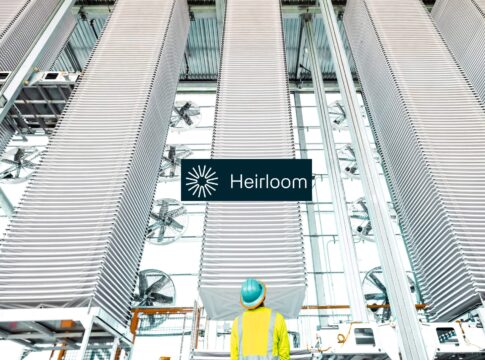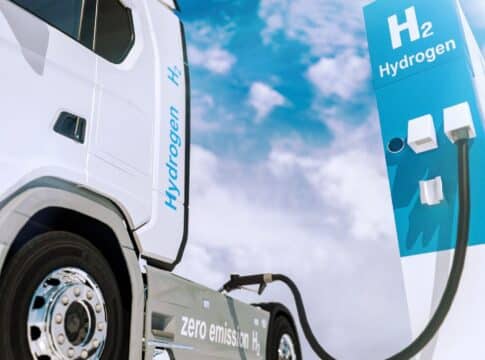Heirloom’s Breakthrough: The Rise of Carbon Capture Revolutionizing Climate Solutions
A US-based Direct Air Capture (DAC) company, Heirloom, launches a novel climate solution that sucks in carbon dioxide from the air using limestone and locking it away in concrete. It is the first commercial DAC plant that opened in the U.S.
Capturing carbon from the air was once seen as unlikely. But today, it’s gaining traction as an important tool to fight the climate crisis. Funds from various sources are pouring into carbon removal initiatives and projects.
In the U.S., the current administration has committed nearly $4 billion towards promoting DAC and other carbon removal initiatives.
How Does Heirloom DAC System Work?
Located in Tracy, California, Heirloom facility aims to capture up to 1,000 tons of CO2 per year using limestone.
The DAC process involves heating the limestone to high temperatures, breaking it down into CO2 and calcium oxide using industrial kilns.
The captured carbon dioxide is then stored in concrete for construction purposes. The remaining calcium oxide is spread on trays, exposed to air, and sucks in carbon naturally. After 3 days, the powder is saturated with CO2 and is returned to the kiln, where the process begins again.
Heirloom claims their system uses fewer energy-intensive fans, leveraging limestone’s natural carbon-attracting properties. Other DAC systems use giant fans to pull CO2 from the atmosphere. Heirloom’s modular facilities enable easy expansion by employing larger trays for limestone and adding more trays to the setup.
The DAC company worked with another climate tech innovator CarbonCure which stores the extracted CO2 in their concrete plants near Heirloom’s facility.
RELATED: Amazon and Microsoft-Backed CarbonCure Raises $80M
The company’s CEO, Shashank Samala, shared that his motivation in developing the technology is the worsening effects of climate change he experiences in his home country, India. Emphasizing the need for impactful climate solutions, he noted that:
“For me, it’s really important to work on a solution that actually has a meaningful, scaled impact on climate change, to actually make a dent on this.”
However, the DAC facility’s capacity to absorb carbon is limited, capturing only 1,000 metric tons of CO2 annually. That’s only a small fraction of what a gas-fired power plant emits yearly.
But the company has an ambitious goal of removing 1 billion tons by 2035, subject to considerable scale up challenge. The company plans to triple this capture capacity each year over the next 12 years to reach that goal.
The Hurdles and The Hope in Carbon Capture
That level of scale up needs a lot of money and the good news is that tech companies are significantly supporting DAC.
For instance, Microsoft has inked a long-term carbon removal agreement with Heirloom. Their deal is to capture up to 315,000 metric tons of CO2, offsetting its own emissions towards its net zero targets. Moreover, Frontier, a carbon removal fund, has pledged massive support to Heirloom and similar carbon capture ventures.
READ MORE: Microsoft’s $200M Carbon Removal Deal Advances Heirloom’s DAC Solution
Heirloom expresses its commitment to using renewable energy from local providers and refrains from accepting investments from oil majors. They asserted that the carbon captured from DAC won’t be used to enhance oil extraction, aligning with their principles of responsible environmental stewardship.
The DAC firm’s latest achievement involves securing a substantial $600 million award from the Department of Energy to establish a processing hub in Louisiana capable of handling up to a million tons of carbon per year. The agency is also supporting the other DAC plant in Texas developed by Occidental Petroleum.
However, despite such advancements, there are still obstacles in significantly reducing carbon dioxide levels.
A mechanical engineer highlights that direct air capture technology remains costly and demands substantial energy. A scientist also underscores the economic challenges in relation to the scale of the atmosphere. He pointed out the uncertainty of entirely resolving the climate crisis, even with the application of all available solutions.
Despite these challenges, Samala remains hopeful that the world increasingly recognizes the important role of DAC in tackling climate change. Comparing carbon capture with waste collection, he said that people should consider paying for removing carbon they generate.
“We need to pay for the CO2 we are putting out there,” he asserts, highlighting the necessity for greater accountability regarding carbon emissions.
Capturing Carbon and Generating Credits
Notably, climate-tech startups focusing on carbon emissions technology received $7.6 billion in venture capital funding in Q3 this year. This VC funding result is defying the downturn trend in fundraising.
Heirloom offers carbon credits that companies and government entities can purchase to offset their emissions. These credits represent an exchange where an individual or company pays for CO2 emissions removed by an entity specializing in carbon capture.
Prominent companies like Stripe, Shopify, Klarna, and Microsoft are among Heirloom’s initial buyers of these credits. The advanced purchasing model allows organizations to offset their emissions by investing in carbon removal initiatives.
RELATED: Carbon Dioxide Removals (CDR) Purchases Jump 437% in First Half of 2023
Positioned as the first commercial DAC plant in the U.S., Heirloom’s system leverages natural properties of limestone that require fewer energy-intensive mechanisms compared to conventional DAC systems. Despite challenges, Heirloom has set ambitious goals, aiming to scale up its carbon capture capacity significantly by collaborating with tech giants and securing substantial funding. The company emphasizes the critical role of DAC in mitigating emissions and fostering a sustainable future.
The post Heirloom’s Breakthrough: The Rise of Carbon Capture Revolutionizing Climate Solutions appeared first on Carbon Credits.



